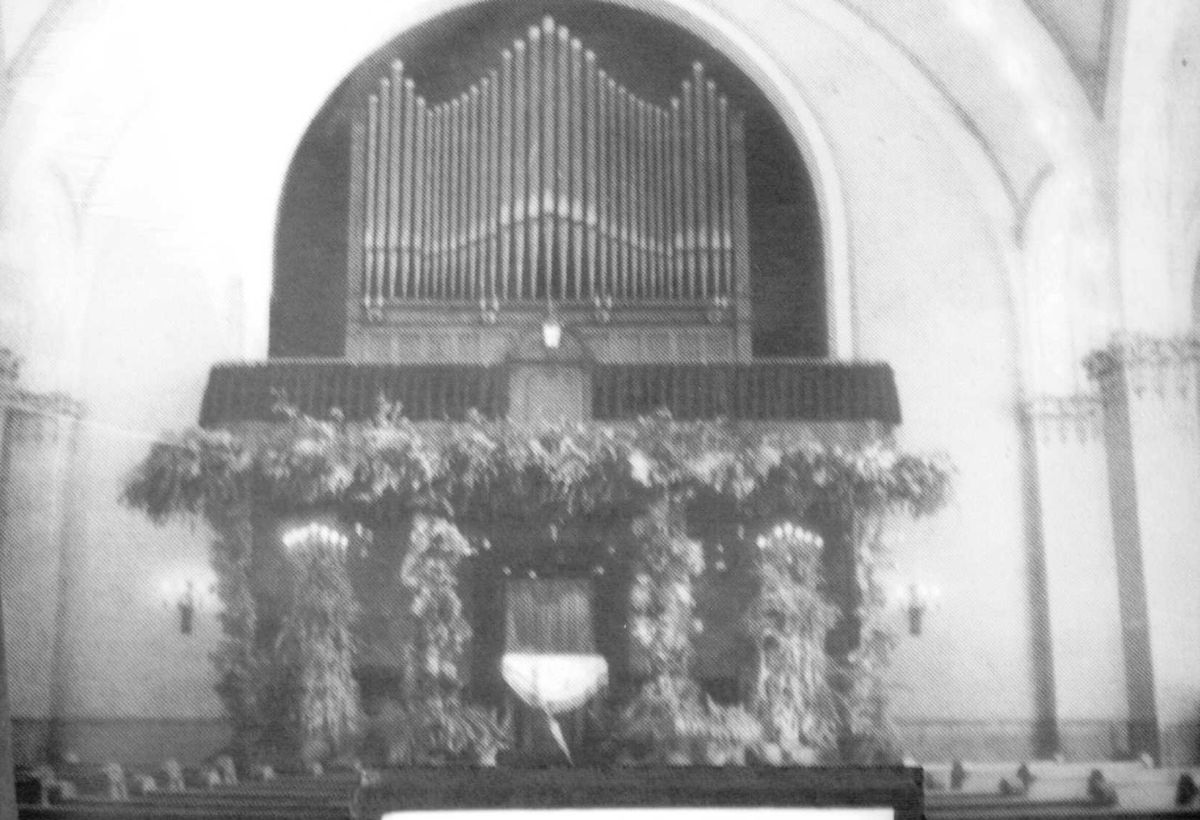
2012-12-12 - Temple Interior and Pipe Facade (early 1900's) (Photograph by Timothy E. Conyers/Database Manager)
Note: Not extant. Not playable. (in this location)

2012-12-12 - This entry describes an original installation of a new pipe organ. Identified by Timothy E. Conyers, based on information from Photos in Temple historical collection, a diorama scene displayed in the current synagogue, and a history of the congregation. -- In 1856 a Jewish congregation was formed in Indianapolis, although Jews had been present in the city since 1849. They chose the name Indianapolis Hebrew Congregation to identify the congregation. Very early they became associated with the Reformed movement of Judaism. The Tenth Street Temple, completed in 1899, was their second building. Rabbi Isaac Mayer Wise, of Cincinnati, an early leader in the Reformed movement, participated in the dedication ceremonies. The auditorium contained several large stained glass windows. One depicted the descent of Moses from Mt. Sinai. This was the first window to contain a human figure in any synagogue in the U.S. Its inclusion divided the congregation as many felt it broke the second commandment. The matter was finally settled when it was referred to Rabbi Wise who reportedly replied the window would hardly tempt even the most indifferent Jew to commit idolatry. The new Temple was dedicated with the window in place. (The window still exists in the present building). <br><br>The sanctuary contained a pipe organ. The choir and organ were located at the front of the room and above the Ark containing the Torah scrolls. The upper arch area of the bema platform contained a large pipe facade. The length of the individual facade pipes followed the curve of the arch. The pipes were of a solid color and were not encased. No console or keydesk is visible in the photos, being hidden by the railing curtain. In Jewish tradition all attention is focused upon the Torah. The photos show a small brass railing with a curtain separating the choir from view. Presumably this was needed for modesty and lessened any distractions caused by the musicians. This is the only period in the history of the Indianapolis Jewish community that a pipe organ existed in any of the synagogues. It served the Reformed congregation for 60 years. The fate of the instrument is currently unknown. In 1957 a new Temple was constructed in what was then the northern part of the city, at 6501 North Meridian Street. This is the current location of the congregation. The old pipe organ was not moved to the new location and its fate is unknown. Today an electric organ is used for services. The Tenth Street Temple was sold to Wings of Deliverance, The Peoples Temple (lead by the infamous cult leader Jim Jones). Purchased later by St. Jude Deliverance Center, the historic structure was totally destroyed by fire in April 1975. If the organ was still in the building at that time, it too was destroyed as only the shell of the building remained. After the fire the building was razed and the lot has remained vacant till today. -Database Manager
2013-01-22 - Updated through online information from Timothy E. Conyers. -- In "The Indianapolis News," October 14, 1899, p. 9, col. 8, is a lengthy article about the new Tenth Street Temple. A description of the instrument is given but no builder is listed. This article confirms the organ was installed when the Temple was built. "Over the rostrum and facing the auditorium is the organ loft with the choir gallery. The organ is of great size and practically fills the spacious loft. This with its many pipes and color affects, make an attractive feature for the front of the auditorium. The organ has been tested by the best musicians of the city, who speak well of its qualities."<br><br>"Indianapolis News", November 2, 1899, p. 8, col. 1, outlines the dedication program for the Temple. The organ was put to good use for this event. Musicians included the choir, a quartet, a trio, soprano soloist and alto soloist, all providing selections throughout the service. In addition to traditional Jewish liturgical music, several works by classical composers, such as Guilmant, Gounod, Mendelsohn and Rossini, were also featured. <br><br>"The Temple Centennial, Indianapolis Hebrew Congregation, 1856 - 1956", p. 15, gives an interesteing occurence with the organ two months after its installation. "...The first wedding ever to take place in the Tenth Street Temple [was] on January 10, 1900. Daisy Levy and Joseph Livingston were married. The bride's father, Leopold Levy, was then State Treasurer...The pipe organ in the Temple was so new that in the middle of the 'Wedding March' all the keys got stuck, and the result was bedlam." (booklet located in Indiana State Library rare book collection). -Database Manager
Regrettably, it is not possible to display the information about the sponsor of this pipeorgandatabase entry or if there is a sponsor. Please see About Sponsors on Pipe Organ Database.